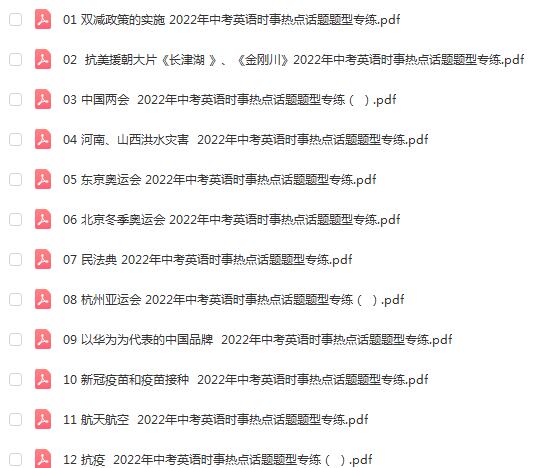中考英语阅读题型解析
发布于 2021-04-24 18:57 ,所属分类:知识学习综合资讯


阅读理解是历年中考重点题型,主要考查考生通过文字获取信息的能力。新教材使用以来,中考阅读理解的考查比重越来越大。篇数也增至三至四篇,选材范围越来越广,除故事、幽默、人物轶事外,科普性文章多了起来。体裁趋于多样化,有记叙文、说明文、应用文等。还要求考生能理解及解释图表所提供的简单信息等。三、四篇短文中有的难度跨度较大,以便拉开档次,体现选拔功能。
阅读理解能力就是把单个词汇意义组合成句子意义的能力和思维能力。它包含理解字面意义的能力和理解深层含义的能力,即不仅要弄懂文字材料所说明的具体事实,还要了解和把握作者的观点、目的等抽象的概念。

新大纲对初中毕业生阅读能力的要求是:能阅读所学语言知识范围内的英语材料,生词率不超过3%。三年制的阅读速度为每分钟40—50个词,理解正确率达到70%。能就阅读内容进行正误判断、完形填空、笔头问答及选择正确的选项完成句子等。

中考对阅读能力的测试主要有以下要求:考生要掌握所读材料的主旨和大意,既理解具体的事实,也理解抽象的概念;既能理解某句、某段的含义,也能通过分析综合把握全篇的脉络;能根据文字材料所提供的信息,综合中学生应有的常识进行推理、判断。


阅读理解能力必须在具备一定英语知识的基础上经过大量的阅读训练,才能逐渐提高的,要想靠短期内临时突击是见不到成效的。所以新大纲规定了初中生课外阅读量应不低于10万字的最低要求。因此考生应从长计议,平时要养成良好的课外阅读习惯,要选择系列性阅读材料由浅入深、坚持不懈地阅读并及时检查阅读效果,通过分析错误原因,不断提高阅读速度和理解准确度。

阅读理解试题通常是给出一篇短文,在短文后面附有若干根据文章内容设计的检查理解程度的测试题,要求考生在阅读理解短文意思的基础上,正确完成这些试题。它不仅要求考生认识单词,懂得语法结构,了解文章的字面意思,而且要有根据文字意思进行逻辑推理和抽象概括的能力。它不仅考查考生综合运用英语语言知识的能力,而且考查考生的阅读的速度及理解能力。



中考阅读重点考查七种题型:
1)事实细节题
2)句义理解题
3)分析判断题
4)逻辑推理题
5)归纳概括题
6)词义猜测题
7)判断正误&任务型阅读


1)事实理解题

通过阅读短文, 可以直接从阅读材料中找到这类问题的答案, 常考查的方面有事件发生的时间、地点、原因、方式、过程、结局、人物之间的关系、事件之间的关系、词和句的含义等。事实细节题设题手段单一,常常针对文章中某个容易误解的关键词句或概念,通过移花接木的手段组成是非辨别选择题,难度较小,属浅层理解题。
事实细节题题干常见的提问形式:
1)True or NOT true是非判断类型
Which of the followingis NOT mentioned inthe passage?
Which of thefollowing statements is NOT true?
Which of thefollowing isNOT considered as……?
According to the passage,which ofthe following is NOT mentioned as one of the reasons for……?
2)特殊疑问词提问类型
How many/What/who/when/where/how/why……?
3)排序题类型Which of the orders is correct according to the passage?
4)例证题类型The author gives the example in……paragraph in order to ……
5)表唯一细节概念题类型:……the most / ~est …………the only ……
事实细节题的解题方法:做这类题的一般方法是先要找出题干或是选项中的关键字,一般为数字、大写或人名地名,再通过scanning快速确定该细节在文中的出处(信息源),仔细对照题干要求,排除或选择。命题者在出这类题时惯用“偷梁换柱、张冠李戴”的手法来迷惑考生,即对原句细微处做改动,截取原文词语或结构进行改造,因果倒置,把A的观点说成B的观点等。所以正确理解题干和信息句的意义是关键。细节事实题还要十分注意句子的非主干成分,如定语、状语、补语等,这些成分都是出题者常进行误导的落脚点。是非判断一般都遵循对照选项进行“三对一错或三错一对”的判断。若该信息句是长句或难句,要学会找出其主干部分,分析句子结构,正确理解信息句的意义。一定要注意的是,要所答是所问,不要受到惯势思维的影响,习惯性地去选择正确的细节事实,切记要弄清问题,不要所答非所问。例证题一定要注意以for example……,such as……等关键入手处,找出细节出处。排序题要先仔细观察选项,找出首尾相同的选项分组,进而通过具体细节信息比较进行排除和选择。唯一细节题一定要仔细审题,弄清题干所需。特别需要提醒的是,选项中出现有most (最高级)、the only(唯一)、all(所有)、none(全否)修饰的细节,都具有绝对性,选择判断时要慎选。特别注意:近几年中考命题中,事实细节题的选项也并非可以直接
在文本中可以找到一模一样的答案,大多是根据意思来分析,需要语言转换、重组、简单概括或简单推断等。


举个栗子
He / she should have an interest in making pizza. More importantly, he/ she should have work experience in a restaurant.
The ad tells us that____
A. The assistant must be a man.
B. The assistant must have once worked in a restaurant.
C. Pucci pizza has branches all over China.
事实理解题解题技巧:
事实细节题一般在:
1文中有原句;
2找相关信息进行比对;
3找近义词或同义句;
4进行简单数学计算;
在读文章时把这些信息划下来
2)句义理解题

句子理解题也叫同义转换题,它主要通过同义转换的方式来考察考生对阅读材料中一些关键词句是如何理解的,试题通过句型转换对短文原句释义,难度可大可小,属于理解题,尤其是在特定语境下对该句子的理解。此类题在近年中考阅读理解题中屡见不鲜,我们重点是应该基于前后的语境,分析该语境的意思。如果是较复杂的句子结构,则首先需要分析该句子结构,再基于语境理解其意。另外,特别需要分析4个选项所表达的意思,分析其侧重点、不同之处,清晰理解他们的意思,再对照文章语境下那个考察句子,哪个选项所表达的意思跟文章那个句子意思样的。

3)分析判断题

分析判断题要求考生在充分理解短文内容的基础上,对文章的结构特点进行分析,以掌握全篇的逻辑关系。此类题一般都属于难度题,做这类题目时首先要研究文章着重说明什么问题,表达什么观点,这是文章的主题。其次要分析作者运用什么样的情节,故事来表达主题,这为文章的中心大意。另外还应注意作者是如何展开故事情节的,运用的是什么写作方法以及最后是如何得出结论的,这为文章的写作结构和手法。分析判断题一定要基于文章的主题意义、写作意图、作者或故事主人公的观点态度及情感以及文章的结构和写作手法等方面进行分析判断。

4)逻辑推理题

此题型要求考生纵观全文,在汇集全文提供的各项信息的基础上进行正确的逻辑推理,推断作者的意向,人物的动机,目的,性格特征,事件的前因后果关系,语言中的语态,语气等,近年来的中考强调对考生阅读能力的考查,因而推理判断式的深层次理解题随之增加,这就要求我们在通读全文,弄懂全文的基础上,抓住文章的关键词句,深入理解文章的内容。推理判断:此类题的关键是要注意原文出现的语句不是我们做出的推理判断,而是原文给出的细节信息,所以原文语句不能选。判断时对已知的事实仔细评价后做出的合理决定并非唯一决定,要对事实进行合乎情理的判断,有时还需借助常识进行判断。推理判断题分两种,即对细节的推理和对主旨的推理。主要以We can infer / imply / learn from this passage that ……等进行提问。解决此类题要注意,一是与原文相同的细节不能选,二是文中没有出现细节不能跳出文章做推断。解题过程中只要注意上述两点,再结合做细节和主旨的方法,即可以做出推理判断题。
1、简单推理:所谓简单推理就是以表面文字为前提,以具体事实为依据进行推理,做出判断。这种推理方式比较直接,只要弄清事实,即可结合常识推断出合理的结论。
2、复杂推理:复杂推理不但要以文字为依据,而且还要以文章的语境、内涵为前提。这是一种间接而复杂的逻辑推理方式。考生要推断出文章没有表明但又合乎逻辑的推理,就必须由表及里地归纳或演绎。下面是几种复杂的推理方法:
(1)推测作者的写作目的和意图,此类的设题形式有:
The purpose in writing this text is to .
The author writes this passage to .
The author in this passage intends to .
推测作者的写作目的,必须要先了解文章的主题,然后分析作者的论述方法、论述的重点和材料的安排。
(2)推测文章的观点或结论,此类设题形式有:
It can be inferred from the passage that
What conclusion can be drawn from the passage?
From the passage we can conclude that .
这类问题问的不一定是全文的中心思想或作者的全部观点,可能只是文章中的某一观点。但要推测出文中的某一观点,仍离不开对全文主要观点或中心思想的把握。
(3)推断文章的出处,设题形式有:
The passage is most likely to be taken from .
Where would this passage most probably appear?
The passage is most likely a part of .
这类问题应从文章的内容或结构来判断其出处:
①报纸:前面会出现日期、地点或通讯社名称;
②广告:因其格式和语言特殊,容易辨认;
③产品说明:器皿、设备的使用说明会有产品名称或操作方式,而药品的服用说明会告知服用时间、次数、药量等。
(4)推断短文中人物性格,设题形式有:
What do we know about somebody in the text?
What kind of man somebody is?
Somebody can be said to be .
做这类题时一定要注意:①准确把握字里行间的意思,切忌用自己的观点代替作者的观点;②特别注意表达情感、态度和观点的词语。
(5)借助文章结构进行推测:有些推断题要从文章结构的角度进行分析,才能推断出正确答案。因此,阅读时不仅要注重词、句的理解,而且还要分析语篇的组织结构。


举个栗子
lSecondly, a news story has to be interesting and unusual. People don’t want to read stories about everyday life. As a result, many stories are about some kinds of danger and seem to be “bad” news.
According to the passage, which of the following can you most possibly watch on TV? ____
a. You often play football with your friends after school.
b. Your teacher has got a cold.
c. A tiger in the city zoo has run out and hasn’t been caught.
d. The bike in front of your house is lost.
lWhen you cough or sneeze, please turn your head away from others and cover your mouth with the full part of your hand. Afterwards, you should say, “Excuse me.” This is a rule I set for my students. It is so simple, but many kids have never been told to do this.
What does the underlined word “this” mean?_
A. Don’t cough or sneeze in front of people
B. Don’t stand beside someone who coughs or sneezes.
C. Many people cough or sneeze on the underground train.
D. Cover your mouth when coughing or sneezing and say sorry.
总结:
解题技巧:推断题在文章无法直接找到答案,须在正确理解文章字面意思的基础上,运用逻辑推理的方法,综合主旨句、主题句和上下文信息以及作者的措辞,作出总结性的判断。同时要特别注意代词所指代的对象。
阅读理解题中难度最大且出现频率很高的是推理判断题,近几年的中考每年都保持在2、3题左右。这种题要求考生根据文章中出现的暗示,抓住内含语义,用逻辑思维的方法加以整理,然后做出合理的判断。推理的方法大致可分为:简单推理和复杂推理。
5)归纳概括题

此题型要求考生在理解全文后,归纳短文大意,概括中心思想,或选择短文标题,这些问题的答案大都隐藏在文章中。不少文章一开头便展示出文章的主题,尤其是新闻报道之类的,第一段常是故事的梗概,这一段往往表达中心思想。但也有不少文章,中心思想贯穿在全文中,考生必须具备一定的归纳概括能力才能选对答案。因此此类题属于难度题。主旨大意:此类题型用以考查学生对文章主题或中心思想的领会和理解能力。其中一类题型为主旨问题。主旨大意题题干常见的问句形式:
(1)What is the main idea of the passage?
(2) The firstparagraph tells us that _____
(3) Which of the following expresses the main idea?
(4) The passage is mainly about ______
(5) The best title for the story is _______
(6) Which of the following is the best title?
Can you find the topic sentence?
主旨大意题的解题方法:主旨大意题一定要注意文章的首尾两段。如果首尾两段的主旨表达是一致的,那么文章的主旨便是两段重复表明的语句内容表达。找出选项中与归纳的主旨表达重复最多的选项即为最佳答案。如果首尾两段的主旨表达不一致,则需要观察文章的段落篇幅量是倾向于首段或是尾段,从而确定主旨段落。在此过程中,观察篇幅量只需跳读文章段落的首句尾句即可,无需细读段落内容,以节省时间。如果文章只有一段,则注意文章的首两句及尾句,然后用以上的方法确定主旨句。此外,标题选择即为主旨句的压缩表达,注意抓住主旨句进行主要词汇的提炼,把一个句子提炼为几个关键词,即是对主旨大意进行概括归纳的标题。而作者意图表达必须通过归纳中心主题才能找到,通常体现为advise,convince,present,propose,warn等。


举个栗子
1.All living things on the earth need other living things to live. Nothing lives alone. Most animals must live in a group, and even a plant grows close together with others of the same kind.Sometimes one living thing kills another, one eats and the other is eaten. Each kind of life eats another kind of life in order to live, and together they form a food chain .Some food chains become broken up if one of the links disappears.
2. Reading is a good habit, but the problem is , there’s too much to read these days, and too little time to read every word of it. There are hundreds of skills to help you read more in less time. Here are two skills that I think are especially good.
解题技巧:此类题目多出现于议论文和说明文。要确定文章的主题思想,最重要的是要找到主题句。主题句一般在段首或段尾,有时也在中间。
3. Do you know more and more Chinese artists have made regular donations to charity or put their efforts into charity work in China? Here let’s know some of them.
What is the passage mainly about? ___
A. Chinese charity work.
B. Charity work of some Chinese artists.
C. Some famous Chinese artists.
D. Organizations started by Chinese artists.
解题技巧:
找主题句。一般新闻报道、说明文、议论文大都采用先总述、后分述的叙事方法,因此主题句大都在段首或篇首。
用归纳法写文章时,往往表述细节的句子在前,概述性的句子在后,并以此结尾。那么主题句往往就在段末或篇末。

6)词义猜测题

词义猜测题要求考生根据上下文,构词法等猜测某个生词的词义或者对某个词语在特定语境中的意义进行猜测。词义猜测是利用上下文语境对某些生词、难句做出推测和判断。该题旨在考查学生根据上下文推断词汇的能力,因而,所考单词的意义通常超出大纲范围。常见形式有:The word / phrase…… means / refers to……From the passage,we can infer the word…… is closestin meaning to……What does the word…… in paragraph……mean?要做好此类题,要注意,第一要熟练掌握大纲单词,平时注意积累生词和短语。第二,要把词放到句子里,把句子放在句群里。第三,注意词、句的位置,确定结构关系。第四,要善于利用连词、代词及词性、同义词法、反义词法等进行判断选择。


举个栗子
1、根据定义、释义
常用的:be, be called, mean,that is(to say),in other words,call, be considered to be, refer to, be called, be known as, define, represent, signify等词汇或破折号或定语从句等来表示。
Well, I’ve relearned it. I hope I have time left to enjoy the successes of others and to take pleasure in the day. That’s the heart of the watermelon.
“the heart of the watermelon” refers to__.
A. the best part of the watermelon.
B. the writer’s busy life
C. the writer’s decision of making money.
D. the writer’s hope of enjoying life.
2、根据上下文情景和逻辑进行判断
As they go around town, they help people. When they find lost children, they take the children home. If they see a fight, they put an end to it right away.
They know all the streets and roads well.
Often people ask them how to get to a place in town.
In the text, “put an end to” means __
A. stop B. cut C. kill D. Fly
3、根据关联词来猜测
表示因果关系的:because, as, since, for, so, as a result…
表示同义关系的:and, like, just as…the same as….
表示反义关系的:but, however, though, although, yet, instead (of)
There is a place on our earth where hot water and steam come up under the ground. It is on a large island in the Pacific Ocean. The island is North Island in New Zealand.
What does the word “steam” mean in Chinese? _____
A. 自来水 B. 大气 C. 冰川 D. 蒸汽
1.I could see nothing because the light was so (faint.)
2.Tom is very rude, but his brother is quite (polite.)
3. She is beautiful, and her daughter is as (pretty )as her.
演练1
A bag is useful and the word “bag” is useful.
It gives us some interesting phrases .
One is “to let the cat out of the bag.” It is the same as “to tell a secret”
Now when someone lets out a secret, he “lets the cat out of the bag.”
Q:John lets the cat out of the bag” means he
A. makes everyone know a secret.
B. the woman bout a cat.
C. buys a cat in the bag.
D. sells the cat in the bag.`
实战演练2
If you want to be a musician, you usually have to move to an area that has a lot of jobs, such as New York City. The cost of living in these areas is usually very high. The third disadvantage is that you can’t have a stable family life. Different jobs will take a musician to different places, so most musicians are unable to have a regular family.
What does the underlined word “stable” mean in Chinese? ________
A. 幸福的 B. 稳定的 C. 健康的
(4)根据生活经验及普通常识猜词
1) China is our motherland.
2) Kangaroo mothers have pouches to carry their babies.
3) It's really cold outside, and my hands are both numb.
Exercises: Guess the meaning of the new words quickly.
a. Wealthy means having lots of money.
b. Doctors believe that smoking is detrimental to your health.
c. My mother-in-law, my husband’s mother, was a teacher. The boy had a happy family before. However, after the war, he became homeless.
d. You must stop dreaming and face reality.
(5)根据构词法猜测词意
在阅读文章时,我们总会遇上一些新词汇,有时很难根据上下文来推断其词意,而它们对文章的理解又有着举足轻重的作用,此时,如掌握了一些常用的词根、前缀、后缀等语法知识,这些问题便不难解决了。例如: 前缀un-表反义词,如happy、unhappy,fair、unfair,important、unimportant等。后缀- ment表名词,如develop、development,state、statement,argue、argument等。后缀-er、-or或-ist表同源名词,如calculate/ calculator; visit/ visitor; law/ lawyer; wait/waiter; science/ scientist; art/ artist等。
(6)通过同义词和同义关系猜测词义
在文章中有时作者为了避免重复,或为了表达同一事物的不同种类,使用同义词或近义词。在这种情况下,我们就可以利用同义词、近义词的关系从熟悉的词语推测不熟悉词语的含义。
通过同义词猜词,一是要看由and或or连接的同义词词组,如happy and gay,即使我们不认识gay这个词,也可以知道它是“愉快”的意思;二是看在进一步解释的过程中所使用的同义词。
Man has known something about the planets Venus, Mars,and Jupiter with the help of spaceships.
(7)通过反义词和反义关系猜测词义
有时作者为了说明相反的两件事或两个人,使用了一些反义词或表示反义关系的词语来进行对比,我们可以利用已知单词推断未知单词的词义。
通过反义词猜词,一是看表转折关系的连词或副词,如but,while,however等,二是看含not的习语或表示否定意义的词语。
(8)通过举例来猜测词义
Bananas, oranges, pineapples, coconuts and some other kinds of fruit grow in warm areas.
(9)通过描述猜测词义
描述即作者为帮助读者更深刻,更感性地了解某人或某物而对该人或该物作出的外在相貌或内在特征的描写。
The penguin is a kind of seabird living in the South Pole. It is fat and walks in a funny way. Although it cannot fly, it can swim in the icy water to catch the fish.
(10)根据单词的发音进行推测
英语中有些单词来自汉语,与汉语发音有些相似,另外也有一些单词译成汉语时采用音译,如:sofa,coffee,typhoon,aspirin,nylon
7)判断正误题和任务型阅读题

以上涉及到的都是在中考题中出现最多的选择型阅读测试题的做题技巧。除此之外,还有正误型阅读和任务型阅读两种考查形式。正误型阅读出现的逐渐减少,难度降低,一般试题在短文中可以直接找到答案,也可以用上述的方法来做题,这里不多讲述。
任务型阅读是近年来推出的新题型,命题灵活,题型多样,可能是问答题,也可能是翻译句子,填写表格信息等,能够很好地考查学生的英语综合能力。但是只要我们注意养成良好的阅读心理,提高阅读速度,就能做好这种题。

温馨提示


1.浏览试题,明确要求。带着问题去读短文,有的放矢。
2.浏览全文,捕捉有用信息。阅读时,注意有关的人物、事件、时间、地点、起因及一些定义、数据和一些关键词语,可以做出标记,有目的地把文后题目和短文中相关信息加以比较,从而找到正确答案。
3.复读全文,抓住细节。答题时有问题,要重新在短文中寻找答案, 注意短文的首尾句或每一段的首尾句,那往往是事件的结果或作者的态度、意图等。
4.再读全文,核对答案。要用全文的主题大意重新审核各题答案,看前后是否一致,是否符合短文的主旨大意,细节方面是否和短文一致,是否有拼写和语法错误等。
5.忌不带问题。做阅读理解题时,应先把文章后面所给的考查题浏览一遍,然后带着这些问题进行阅读。边阅读边选出考查表层情况问题的答案,从而提高阅读效果。
6.忌草率行事。在设计理解题时,设计者往往在四个选项中设计出一个似是而非的答案。这样答案干扰性特别强,容易迷惑考生。如果在发现一个看似正确答案时就草率定案,往往会掉进设计者设置的“陷阱”里。处理的方法是:对所给四个备选答案进行分析比较,在理解阅读材料内容的基础上进行去伪存真,方可选出正确答案。在做完所有题目后,不可孤立地检查每个小题。应该遵循由整体到部分,再由部分到整体的理解文章的规律,再次耐心地复读全文,使自己对全文意思的理解程度会更清楚,如果发现怀疑的答案,不要随意改动,一定要从原文中找到依据,才能改正,不可草率了事。因此,尚未读懂的地方如果时间允许的话,一定要慢速多读几遍,直到读懂时再定答案。
7.忌主观印象。少数阅读不明确题只需根据生活常识就可选出答案,而绝大多数则不然,考生必须按照原文来选定答案。因此,考生在做后一种测试题时,一定要排除自身的生活经验、经历和已有的知识等主观因素的干扰,按照文章实际反映的情况来选择答案。
8.忌忽略时间。做阅读理解题时,一定要从整体上控制时间,时间分配根据文章的难易程度有别。文中一两处没弄懂的地方可以暂且放置一边,等把全部题做完后,再回头来处理。因为做完题后,你的心情相对放松了往往会产生新的思路、新的灵感。即使做完题后时间所剩无几了,你再把未处理的题猜测一下也不晚,因为你仍然有选对的可能性。
































相关资源